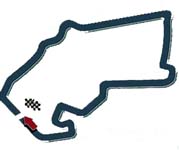| |
|
|
Jum'at - 13/7
Latihan Bebas 1
Latihan Bebas 2 |
Sabtu - 14/7
Latihan Bebas 1
Latihan Bebas 2
Kualifikasi |
Minggu - 15/7
Pemanasan
Balapan |
Circuit information:
| Round Number: |
11 |
|
| Race Date: |
15-07-2001 |
|
| Country: |
Great Britain |
|
| City: |
Silverstone
(click for location
map) |
|
| Circuit Name: |
Silverstone |
|
| Circuit Length: |
5141 m. |
|
| Number of Laps: |
60 |
|
| Race Length: |
308.356 m |
|
| 2000 Pole Position: |
Rubens Barrichello |
|
| 2000 Winner: |
David Coulthard |
|
| 2000 Fastest Lap: |
Mika Häkkinen |
|

|
GAMBARAN SIRKUIT |
|
Gambaran
sirkuit
ini

|
|
Circuit
Description, History, Facts and
Figures
|
Along with the Italian Grand Prix, the British
event can claim to be the longest running
fixture on the official Formula One calendar.
The Drivers' Championship celebrated its
fiftieth anniversary last year and so did the
British Grand Prix.
While France can claim to have invented the
sport, Great Britain has had the greatest
influence on its development. 181 of the 649
grands prix held to date have been won by
British drivers, over twice as many as joint
second placed countries, France and Brazil.
Twelve of the fifty world championships were
claimed by British drivers, dating back to Mike
Hawthorn's 1958 title at the wheel of a Ferrari.
Four drivers can regard this weekend's race as
their home event, but the British influence goes
much deeper than that as seven of the eleven
teams taking part are based here, including The
West McLaren Mercedes team, while the remaining
four equipes all employ British staff to a
greater or lesser degree. To find out how this
came about, you have to go back to the end of
the Second World War. Pre-war, motor racing had
been a popular hobby for the well-heeled, but
many of the classic race tracks like Brooklands
were now derelict and overgrown with weeds.
However, there were many military airfields and
keen racers immediately saw their potential as
race tracks. Motor clubs were set up, the most
famous being the 750 MC which is still going
strong today and faced with a shortage of cars,
engineer/drivers built their own with whatever
materials were available. Necessity being the
mother of invention, as Frank Zappa reminded us
a couple of decades later, a tradition of race
car engineering was born, which would form the
basis of what is now a multi-million pound
industry.
Today, as well as the seven Formula One teams
based in Britain, over six hundred engineering
companies and around thirty thousand people owe
their jobs to Formula One. Broadening the search
to include peripheral activities like catering,
marketing and the media the number of people
involved is reckoned to hit the fifty thousand
mark. All that hard work reaps its reward,
generating a turnover of around two billion
pounds, much of it helping Britain's export
drive.
Silverstone was one of those early pioneering
airfields-cum-race-tracks and it is worth
noting, at a time when the circuit is fighting
for the right to stage the British GP that it is
at the epicentre of what can be regarded as
motor racing's very own Silicon Valley. Six of
the seven British-based teams can all get their
cars and personnel from factory to track in
around half an hour- but not on race day of
course, when the famous Silverstone traffic jam
at least serves to prove the continuing
popularity of the sport in a country that has
done so much to keep it fit and well. |
|
|
|
|
|

|
|
Sirkuit - 2001 |
|
| |




















